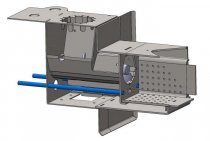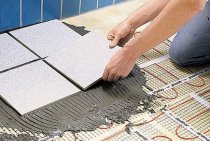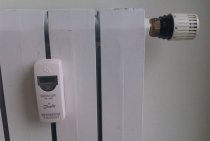Strapping scheme classic version
The connection diagram of the electric boiler must ensure that there are no significant temperature fluctuations. Most often, double-circuit boilers are used. passing through a small circuit, water (oil or antifreeze) heats up, after which it goes along a large one. This should also be taken into account in the scheme.
The piping of the electric boiler assumes the presence of:
- brackets;
- filter;
- Stop valves;
- Valves (return and protection);
- expansion tank;
- Pump (if required);
- Thermometer and manometer;
There are the following types of strapping:
- With the installation of a hot water circuit (oil or antifreeze): before entering the tap, the coolant passes through the electric boiler;
- With connection to the underfloor heating system;
- Normal electrical connection.
When piping a double-circuit boiler, its type is determined by the model (with or without a mixer). It is quite difficult to install it at home with your own hands, because here, along with the correct connection to the mains, you also have to control the connection to the hot water supply.
The connection diagram for the electric boiler is different for each model (it is attached with the purchase when purchasing the device). If you do not have enough time or you are not sure that you can do everything right yourself, it is better not to start tying, relying only on your intuition and videos on the Internet. For 5-30 thousand rubles, specialists will perform such work. But if you make mistakes at the first stage, you can subsequently not only incur much higher expenses, but also endanger yourself and other residents of a private house.
Connection of equipment with other boilers and heat accumulator
To integrate a heat generator into the system, you need to use a circuit with two check valves, an overhead thermostat and a room temperature controller. Such a piping scheme for the heating boiler will allow capturing and redirecting the cooling coolant to the heater after the heating element is turned off.
Consider how to connect an electric boiler to a solid fuel boiler in stages:
- While solid fuel equipment (TT) operates as the main one, the electric boiler is auxiliary and operates in standby mode.
- After the fuel bookmark burns out, the temperature in the room drops. As soon as the heat level drops to the standard set by the owner, the room thermostat will turn on the electric heater.
- The overhead thermostat will detect a decrease in the temperature of the coolant in the return pipeline and turn off the pump.
- After laying the next portion of fuel, the heating is restored, the thermostat turns on the pump. The electric boiler sensor “detects” the heated coolant and will not start the equipment until it receives a command from the thermostat.
To make the installation of an electric boiler into the system clearer, watch a video from professionals.
On a note! The shown method of how to embed an electric boiler into a heating system is also useful for tying gas, diesel-type equipment. In this scheme, the equipment is auxiliary, not the main one.
It would not be superfluous to integrate a buffer tank or a heat accumulator into the circuit. This equipment will save energy when generating its surplus and then redistribute the heat supply when the need arises. For example, when the boiler is operating at full capacity at night (in the case of electric boilers, it is more profitable to do this at the night rate), the accumulated heat is enough to maintain a comfortable temperature during the day.
The mixing unit with a three-way valve will perform the task of redirecting the coolant at the required temperature to the radiators. Thermal accumulators support the heating level up to +80 C. +90 C.When installing water-heated floors in rooms, it is necessary to equip a second mixing unit that heats the coolant to +45 C - this is the established water heating indicator for underfloor heating circuits.
Materials used
The materials for the piping circuit of an electric boiler must ensure the safe operation of the equipment and comply with the requirements of state norms and standards for operation, the rules for the technical and safe operation of consumer electrical installations.
Requirements for piping electric heating boilers:
- The power supply is carried out with a copper wire with a cross section indicated in the passport;
- grounding must be carried out in accordance with the requirements of the PUE, and checked annually for operability;
- a separate cable with an automatic safety switch must be installed;
- it is forbidden to use gas, water and sewer systems as a ground loop.
Before choosing a material for tying an electric boiler, you need to familiarize yourself with its technical capabilities that affect the operation of electric heating. For pipes, important characteristics are thermal insulation properties, the ability to perform complex designs and the cost of strapping. The most common piping solutions are polypropylene or copper pipes.
Binding with copper pipes
Installation using copper pipes requires certain experience from the performers, and significant material resources from the users.
Advantages of copper pipes:
- The high heat transfer coefficient of copper - the heating of the room is carried out not only by heating devices, but also by the piping system.
- High anti-corrosion protection, although pipes become covered with a thin layer of corrosion over time, but it does not affect performance.
- There is no threat of rupture of the pipeline system from freezing. This is due to the fact that copper is more ductile and can withstand freezing loads without breaking its integrity.
 Tying an electric boiler with copper pipes
Tying an electric boiler with copper pipes
- High installation cost;
- it is not allowed to deepen copper pipes into the wall;
- the need for high quality insulation;
- protection against stray currents, the effect of which on copper is detrimental.
Tying with polypropylene pipes
Many users consider polypropylene to be the ideal EC strapping option. This pipe option is reinforced with fiberglass reinforcement for heat resistance. The smooth, anti-corrosion inner surface of the pipes ensures excellent circulation of the heating water. Installation technology using special welding equipment ensures high quality of work without coolant leakage. When preparing a thermal heating scheme and breaking it down into heating sections, one should take into account the features of plastic - a high coefficient of expansion and heat loss. Therefore, it is not recommended to choose sections with a large length of pipes.
The connection of polypropylene pipes is performed in 2 ways: soldering and using fittings. The first method is the most reliable, practically does not allow leaks, the second is less reliable, even with a slight displacement, hot water begins to seep.
Modern polypropylene pipes are characterized by long service life - 40 years or more and high strength, able to easily withstand pressure up to 25 bar. The latest modifications of these pipes received protection against excessive expansion, today even heating the coolant to 95 C does not cause deformation.
Installation nuances
First of all, it should be said that there are two types of systems with an electric heat generator:
- With natural pressure on the coolant (the electric boiler is located at the bottom of the circuit).
- With forced circulation (you can find a video with a detailed analysis of the installation of the pump on the website).It is possible to locate the boiler at any point in the chain (with the exception of the highest).
Many owners of a private house install not one, but two electric boilers. "just in case". If the backup device does not work at full capacity, then the installation of the electric boiler is carried out in parallel, so that both generators work with the same power.
Strapping scheme
As already mentioned, the correct execution of the strapping is of paramount importance.
At the same time, it is especially important to take into account not only how to calculate an electric boiler for heating, but also its main purpose is to control the level of temperature difference of the coolant at the inlet and outlet of the boiler. Initially, the coolant, which has reached a certain temperature, passes through a small circuit
And only after that, hot water is distributed throughout the system, heating the radiators, and, thereby, raising the air temperature in the room. From this we can draw a simple conclusion - in order to create the temperature necessary for its high-quality operation in the system, it is necessary to create several heating circuits.
To create a harness you need:
- circulation pump;
- distribution valve;
- balancing crane;
- manometer;
- inline filter;
- radiators;
- pipes of different diameters;
In addition, you may need wrenches and a welding machine. Of course, a heating system with an electric boiler cannot function without tees, adapters, valves (safety, check, air), fasteners (couplings, bolts, nuts).
There are 4 different principles for piping an electric boiler:
- with natural circulation;
- with forced circulation;
- classic wiring;
- on primary and secondary rings.
Scheme with forced circulation of the coolant
Scheme with forced circulation of the coolant. 1 – room temperature controller; 2 - safety block (safety cap, pressure gauge); 3 - radiators; 4 - heating boiler; 5 - expansion tank of a closed type; 6 - pump; 7 - tap for replenishing the amount of water in the system; 8 - anti-condensate pump; 9 - check valve; 10 - minimum temperature sensor.
If the heating system with an electric boiler is based on the operation of a wall-mounted heating boiler, all the elements that it includes are also included in the piping.
At the same time, it may include, in addition to heating, also hot water supply and a "warm floor" system. It should be noted that connecting the system according to the instructions will not be a problem if all instructions are followed exactly. However, this applies only to single-circuit systems. When installing double-circuit, everything is much more complicated. In this case, you can perform both direct strapping and mixing. The main difference between these types of strapping is the principle of temperature control.
Sequence of work
A typical piping scheme assumes the places and sequence of equipment installation, the piping system, the type and type of equipment, the number of circuits, the type of heating elements, the wiring diagram with equipment and protection devices. When the heating system has a large resistance, for example, multi-circuit heating or a "warm floor" system, then a circular electric pump is installed.
Strapping sequence:
- To begin with, securely install the boiler on the wall or floor. The heating element is fixed at least 1.5 m from the floor level, induction or electrode devices are fixed lower, according to the conditions of the strapping.
- Perform the installation of a distribution manifold from the boiler.
- Connect pipes of the required diameter to the inlet and outlet pipes of the EC.
- A three-way valve with a mixer function is installed to regulate the temperature of the coolant.
- Mount the circulation pump on the return line.
- Install protection devices for heating boilers, consisting of 2 valves and a pressure gauge installed at the outlet of the EC.
Piping scheme for a natural circulation system
A typical heating system for objects according to the principle of natural circulation of the coolant requires the installation of the main elements:
- Room thermostat for temperature control;
- heating appliances - radiators and convectors;
- open type air tank;
- shut-off and control valves and a tap for feeding the network circuit.
The technology of piping an electric boiler with a natural movement of the medium is simple and affordable for self-assembly. It is simplified due to the lack of a pump to move the coolant.
Heated water moves along the contour, made with strict observance of slopes, thanks to the physical laws of the movement of hot and cold media. It is applicable for individual heating of one-storey buildings with small heating areas.
Piping with forced circulation
In this scheme, the circulation pump is additionally tied up: a bypass line, power supply, shut-off and control valves and a security system with temperature and pressure sensors. This is the most optimal scheme for automatic control of the heating and hot water levels. The owner of the facility can choose different temperatures for different rooms, although it will require an increase in the cost of heating for the electricity costs to operate the pump.
Algorithm for piping an electric heating boiler, a diagram of a heating element electric boiler:
- Connect the outlet pipes to the network pipeline through ball valves and an American.
- A membrane-type expansion tank and a mesh sump are mounted in the return line to filter suspended sludge and debris in the network water.
- To clean the sump, a ball valve is installed in front of it.
- A circulation pump is installed in schemes with forced circulation, if it is not included in the boiler delivery set, then it is purchased additionally, the selection is carried out according to the volume of water that is budded along the boiler circuit and indicated in the passport.
- A safety group is installed: a pressure gauge, an air vent and a safety relief valve that prevents pressure from increasing in the system.
emergency harness
This type of strapping is mandatory for double-circuit electric boilers; it is performed for the safe operation of all equipment, for example, a sudden power outage.
There are several options for emergency piping of EC:
- Water circulation via bypass with tap water make-up. The scheme has little use, due to the fact that often when the power is turned off, the water is also turned off.
- The emergency power source for the circulation pump is a battery. It must always be in a charged state, thus the circuit requires constant attendants to charge and maintain the batteries.
- Gravity circulation - a special circuit with a minimum load connection, for cooling the coolant, heats only a small part of the rooms. This scheme is the most efficient solution.
You can draw a line, indeed, tying an electric boiler for autonomous heating is not difficult. Nevertheless, the contractor will be required to be meticulous in the execution and quality assurance of the connections. The owner and the installation organization will be required to comply with the Electrical Safety Rules and comply with the accuracy of the manufacturer's wiring diagram indicated in the technical documents of the electric boiler.



